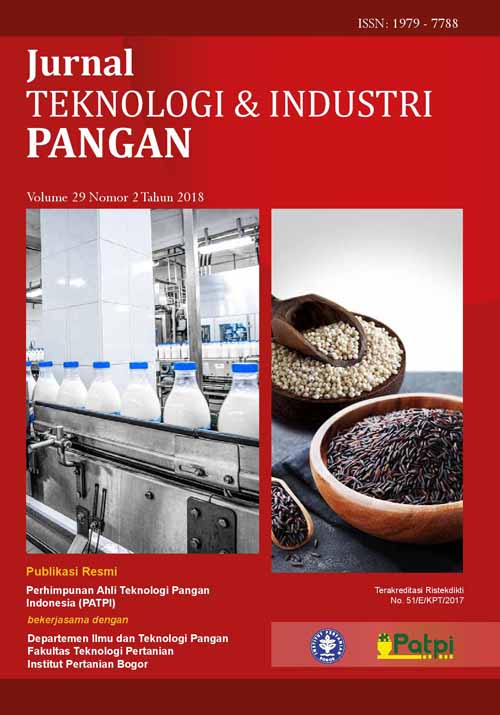LABEL TIME-TEMPERATURE INDICATOR MENGGUNAKAN CAMPURAN MINYAK NABATI UNTUK MEMONITOR MUTU MIKROBIOLOGI SUSU PASTEURISASI
Abstract
Pasteurized milk (PM) is a perishable product requiring storage at cold temperatures to maintain its shelf life. However, the temperature fluctuations during transportation, handling, and storage could affect the number of microbial counts of the product. A time-temperature indicator (TTI) can be used to monitor product conditions in real time, so consumers know the condition of the product during transportation and storage. This study aims to determine the ability of a mixed vegetable oil (VOB) as a TTI indicator and evaluate the validity of TTI as an indicator of PM microbiological degradation. The VOB was produced from a mixture of palm oil (PO), canola oil (CA), and olive oil (OV) at ratios of 50:40:10 (C1), 50:25:25 (C2), and 50:10:40% (v/v) (C3), with the addition of 0.25% (m/v) of red dye (CI 16255). The VOBs were tested its for diffusion length, diffusion kinetics, and the accuracy of the prediction model of each indicator at isothermal temperatures. The VOB indicator can be applied to monitor the total growth of microbes in PM. The value of the activation energy (Ea) of each indicator was 34.289 (C1); 35,294 (C2) and 40,646 kJ/mol (C3), while the Ea value of the microbial spoilage in PM was 58,105 kJ/mol. The difference between the Ea PM value and each indicator was less than 25 kJ/mol. Indicating that the accuracy of the prediction model was good. At storage temperature of 29°C, the critical limit for PM spoilage occurs after 24 hours of storage which correlated with the diffusion length indicator of 6.50 (C1), 6.25 (C2), and 5.5 cm (C3). Overall, the indicators observed can be used to monitor the microbiological spoilage of PM, so that the actual quality of PM before consumption can be estimated.
References
Budiyono H. 2009. Analisis daya simpan produk susu pasteurisasi berdasarkan kualitas bahan baku mutu susu. J Paradigma 10: 198-211.
Ellouze M, Augustin JC. 2010. Applicability of biolo-gical time and temperature integrators as quali-ty and safety indicators for meat products. Int J Food Microbiol 138: 119-129. DOI: 10.1016/j. ijfoodmicro.2009.12.012..
Giannoglou M, Touli A, Platakou E, Tsironi T, Taoukis PS. 2014. Predictive modeling and selection of TTI smart labels for monitoring the quality and shelf-life of frozen seafood. Innov Food Sci Emerg 26: 294-301. DOI: 10.1016/j. ifset.2014.10.008.
Hashempour-Baltork F, Torbati M, Azadmard-Damirchi S, Savage GP. 2016. Trends in food science and technology vegetable oil blending: A review of physicochemical, nutritional, and health effects. Tends Food Sci Tech 57: 52-58. DOI: 10.1016/j.tifs.2016.09.007.
Kim J, Kim DN, Lee SH, Yoo SH, Lee S. 2010. Cor-relation of fatty acid composition of vegetable oils with rheological behaviour and oil uptake. Food Chem 118: 398-402. DOI: 10.1016/j. foodchem.2009.05.011.
Kim JU, Ghafoor K, Ahn J, Shin S, Lee SH, Shahbaz HM, Shin HH, Kim
S, Park J. 2015. Kinetic mo-delling and characterization of a diffusion-based Time Temperature Indicator (TTI) for monitoring microbial quality of non pasteurized angelica juice. LWT-Food Sci Tech 67: 143-150. DOI: 10.1016/j.lwt.2015.11.034.
Octaviasari R. 2014. Identifikasi indikator dan medium untuk label cerdas pencatat umur simpan produk [Skripsi]. Bogor: Fakultas Teknologi Pertanian, Institut Pertanian Bogor.
Pereira VA, de Arruda INQ, Stefani R. 2015. Active chitosan/PVA films with anthocyanins from Brassica oleraceae (red cabbage) as time-tem-perature indicators for aplication in intelligent food packaging. Food Hydrocolloid 43: 180-188. DOI:
10.1016/j.foodhyd.2014.05.014.
Roiaini M, Ardiannie T, Norhayati H. 2015. Physico-chemical properties of canola oil, oilve oil, and palm olein blends. Int Food Res J 22: 1227-1233.
Rosyidah T. 2005. Aproksimasi fungsi suhu ter-hadap koefisien difusi pada suatu zat cair [Skripsi]. Jember: Fakultas Keguruan dan Ilmu Pendidikan, Universitas Jember.
Setiawan J. 2012. Pengembangan program perhi-tungan koefisien difusi material dalam rekayasa permukaan. Widyariset 15: 551-556.
Suppakul P, Kim DY, Yang JH, Lee SB, Lee SJ. 2017 November.
Practical design of a diffusion-type time-temperature indicator with intrinsic low temperature dependency. J Food Eng 223: 22-31. DOI: 10.1016/j.jfoodeng.2017.11.026.
Wang S, Liu X, Yang M, Zhang Y, Xiang K, Tang R. 2015. Review of time temperature indicators as quality monitors in food packaging. Packag Technol Sci 28: 839-867. DOI: 10.1002/pts. 2148.
Zhou L, Nyberg K, Rowat AC. 2015. Understanding diffusion theory and Fick’s law through food and cooking. Adv Physiol Educ 39: 192-197. DOI: 10.1152/advan.00133.2014.

